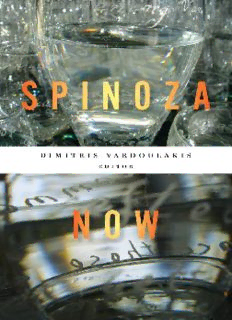
Spinoza Now PDF
Preview Spinoza Now
SPINOZA NOW This page intentionally left blank SPINOZA NOW Dimitris Vardoulakis editor University of Minnesota Press Minneapolis London A different version of chapter 14 was previously published as Alexander García Düttmann, “Viertes Modell: Leben und Tod,” in Derrida und ich: Das Problem der Dekonstruktion, 137–50 (Bielefeld, Germany: Transcript, 2008). Copyright 2011 by the Regents of the University of Minnesota All rights reserved. No part of this publication may be reproduced, stored in a retrieval system, or transmitted, in any form or by any means, electronic, mechanical, photocopying, recording, or otherwise, without the prior written permission of the publisher. Published by the University of Minnesota Press 111 Third Avenue South, Suite 290 Minneapolis, MN 55401-2520 http://www.upress.umn.edu Library of Congress Cataloging-in-Publication Data Spinoza now / Dimitris Vardoulakis, editor. p. cm. Includes bibliographical references and index. ISBN 978-0-8166-7280-6 (hc : alk. paper) ISBN 978-0-8166-7281-3 (pb : alk. paper) 1. Spinoza, Benedictus de, 1632–1677. I. Vardoulakis, Dimitris. B3998.S745 2011 199'.492—dc22 2010032605 Printed in the United States of America on acid-free paper The University of Minnesota is an equal-opportunity educator and employer. 17 16 15 14 13 12 11 10 9 8 7 6 5 4 3 2 1 Contents Note on References to Spinoza’s Works............. vii Editor’s Note.....................................ix Spinoza Now: An Introduction .....................xi Dimitris Vardoulakis Part I. Strategies for Reading Spinoza 1. Spinoza and the Conflict of Interpretations ....... 3 Christopher Norris 2. What Is a Proof in Spinoza’s Ethics?............. 39 Alain Badiou 3. The Joyful Passions in Spinoza’s Theory of Relations........................... 51 Simon Duffy 4. Spinoza’s Ass................................. 65 Justin Clemens Part II. Politics, Theology, and Interpretation 5. Toward an Inclusive Universalism: Spinoza’s Ethics of Sustainability ............... 99 Michael Mack 6. Prophecy without Prophets: Spinoza and Maimonides on Law and the Democracy of Knowledge............................... 135 Arthur J. Jacobson 7. Interjecting Empty Spaces: Imagination and Interpretation in Spinoza’s Tractatus Theologico-Politicus ........................... 161 Warren Montag 8. Marx before Spinoza: Notes toward an Investigation ............................. 179 Cesare Casarino Part III. Spinoza and the Arts 9. Image and Machine: Introduction to Thomas Hirschhorn’s Spinoza Monument........ 237 Sebastian Egenhofer 10. Spinoza, Ratiocination, and Art................ 263 Anthony Uhlmann 11. An Inter-action: Rembrandt and Spinoza........ 277 Mieke Bal and Dimitris Vardoulakis Part IV. Encounters about Life and Death 12. Power and Ontology between Heidegger and Spinoza....................... 307 Antonio Negri 13. A Thought beyond Dualisms, Creationist and Evolutionist Alike.............. 321 A. Kiarina Kordela 14. A Matter of Life and Death: Spinoza and Derrida ......................... 351 Alexander García Düttmann Contributors................................... 363 Index.......................................... 369 Note on References to Spinoza’s Works the various translations of Spinoza’s works offer often signifi- cantly different interpretations of the meaning of his original Latin text. For this reason, the contributors have been free to choose their preferred translations or to translate themselves the Latin from the established text of Spinoza’s works in the Gebhardt edition of the Opera. In references to the Ethics, the Roman numeral indicates the part of the Ethicsto which the author is referring, e.g., Ethics I is Ethics, Part I; Ethics II is Ethics, Part II; and so on. In addition, the following abbreviations are used: A axiom Ap. appendix C corollary D definition L lemma P proposition Pr. proof S scholium For instance, Ethics II, P7, refers to Ethics, Part II, Proposition 7, and Ethics IV, P34S, refers to Ethics, Part IV, Scholium to Proposition 34. vii This page intentionally left blank Editor’s Note Spinoza Now attempts to place Spinoza in a contemporary context. This project started in 2005 at the Centre for Ideas of the Victorian College of the Arts, Melbourne, Australia. A number of the papers published here were first presented at the conference Wandering with Spinoza, held at the Centre for Ideas from September 13 to 15, 2006. The editor would like to thank the director of the Centre for Ideas, Elizabeth Presa, for her unwavering belief in the value of such a project. The editor also thanks Norma Lam-Saw for research assistance. ix
Description: